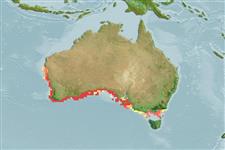>
Eupercaria/misc (Various families in series Eupercaria) >
Labridae (Wrasses)
Etymology: Notolabrus: Greek, noton = back + Greek, labros = voracious (Ref. 45335); parilus: Specific epithet from the aboriginal word 'paril', the name given by the natives of King George Sound to this species..
More on author: Richardson.
Environment: milieu / climate zone / depth range / distribution range
पारिस्थितिकी
समुद्री प्रवाल-भित्ति संयुक्त. Subtropical
Eastern Indian Ocean: Victoria, South Australia and southern Western Australia.
आकार / वज़न / Age
Maturity: Lm ? range ? - ? cm
Max length : 41.0 cm पुल्लिंग / अलिंग; (Ref. 92478)
Inhabits rock reef (Ref. 75154).
Life cycle and mating behavior
परिपक्व अवधि | पुनरुत्पत्ति | मछलीऔ का अंडे देना | अंडे | Fecundity | लार्वा
Oviparous, distinct pairing during breeding (Ref. 205).
Russell, B.C., 1988. Revision of the labrid fish genus Pseudolabrus and allied genera. Rec. Aust. Mus. (Suppl. 9):1-72. (Ref. 26203)
IUCN Red List Status (Ref. 130435)
Threat to humans
Harmless
Human uses
अधिक जानकारी
आम नामउपशब्दचपायचयपरभक्षीईकोटोकसीकोलौजीपुनरुत्पत्तिपरिपक्व अवधिमछलीऔ का अंडे देनाSpawning aggregationFecundityअंडेEgg development
संदर्भजलीयकृषिजलीयकृषि रूपरेखाखींचआनुवंशिकीElectrophoresesहैरेटिबिलटीबीमारीप्रक्रमणNutrientsMass conversion
सहयोगीयोतस्वीरेStamps, Coins Misc.ध्वनिसिगुयटिरारफ्तारतैरने के प्रकारगिल क्षेत्रOtolithsदिमागदृष्टि
साधन
Special reports
Download XML
इंटरनेट स्रोत
Estimates based on models
Preferred temperature (Ref.
123201): 15.3 - 22.4, mean 17.8 °C (based on 220 cells).
Phylogenetic diversity index (Ref.
82804): PD
50 = 0.5078 [Uniqueness, from 0.5 = low to 2.0 = high].
Bayesian length-weight: a=0.00955 (0.00456 - 0.02002), b=3.06 (2.89 - 3.23), in cm total length, based on LWR estimates for this (Sub)family-body shape (Ref.
93245).
Trophic level (Ref.
69278): 3.6 ±0.5 se; based on size and trophs of closest relatives
Generation time: 7.3 ( na - na) years. Estimated as median ln(3)/K based on 2
growth studies.
लौटाव (Ref.
120179): निम्न, न्यूनतम जनसंख्या दुगनी होने का समय 4.5 - 14 वर्ष। (Preliminary K or Fecundity.).
Fishing Vulnerability (Ref.
59153): Low to moderate vulnerability (30 of 100).
Nutrients (Ref.
124155): Calcium = 151 [50, 501] mg/100g; Iron = 0.818 [0.333, 2.285] mg/100g; Protein = 18.1 [15.1, 20.6] %; Omega3 = 0.372 [0.141, 0.986] g/100g; Selenium = 5.24 [1.43, 18.42] μg/100g; VitaminA = 961 [131, 7,176] μg/100g; Zinc = 2.62 [1.26, 5.49] mg/100g (wet weight);
